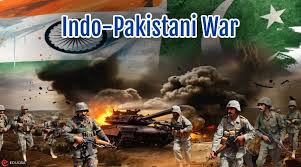Islamabad/New Delhi – Tensions between nuclear-armed neighbors India and Pakistan have erupted into a full-blown military conflict, raising fears of a devastating war in the South Asian region. The escalation follows a series of cross-border attacks, retaliatory strikes, and a breakdown of diplomatic relations, plunging the two nations into their most dangerous standoff in decades.
The Spark: Pahalgam Attack and Initial Retaliation
The current crisis was ignited by a deadly attack on tourists in the Pahalgam region of Indian-controlled Kashmir on April 22nd. The attack, which claimed the lives of 26 civilians, predominantly Hindu Indian tourists, was swiftly blamed by India on Pakistan-backed militant groups. Pakistan vehemently denied these accusations.
In the immediate aftermath, India conducted a series of airstrikes on what it described as militant training camps within Pakistani territory. Pakistan condemned these strikes, stating that they resulted in civilian casualties. This exchange of fire marked a significant departure from previous skirmishes, signaling a dangerous escalation.
Tit-for-Tat Strikes and Rising Casualties
Following the initial Indian airstrikes, Pakistan launched a series of retaliatory attacks, including artillery fire, drone incursions, and missile strikes. These attacks targeted multiple locations in Indian-administered Jammu and Kashmir, as well as other areas. India reported thwarting several of these attacks, claiming to have inflicted significant damage on Pakistani military installations. Pakistan, in turn, claimed to have downed Indian fighter jets and struck key infrastructure.
The exchange of fire has resulted in a rising number of casualties on both sides of the border. Reports indicate civilian deaths and injuries, with both nations accusing the other of indiscriminate shelling and targeting non-combatants. The situation is rapidly deteriorating, with each side vowing further retaliation for perceived aggression.
Diplomatic Breakdown and International Response
The military escalation has been accompanied by a complete breakdown in diplomatic relations. Both India and Pakistan have expelled each other’s diplomats, closed their borders, and suspended cross-border travel. All bilateral talks have been suspended, and any semblance of communication between the two governments has ceased.
The international community has expressed deep concern over the escalating conflict. The United Nations Security Council convened an emergency session to discuss the situation, with the Secretary-General calling for restraint and de-escalation. Several countries, including the United States, China, and Russia, have issued statements urging both sides to return to dialogue and avoid further military action. However, these calls have, so far, gone unheeded.
Impact on the Region and Beyond
The conflict is having a severe impact on the region. Thousands of civilians have been displaced from their homes, seeking refuge in temporary shelters. Schools and businesses have been forced to close, and daily life has been disrupted. The economic consequences are also significant, with both countries facing potential recessions due to the conflict.
The suspension of the Indian Premier League (IPL), a major sporting event, and the relocation of Pakistan’s domestic cricket tournament highlight the widespread impact of the crisis. The closure of several airports in northern India has disrupted air travel, and the Indian stock market has seen significant declines.
The conflict also raises concerns about the potential for nuclear escalation. Both India and Pakistan possess nuclear weapons, and the possibility of their use, however remote, casts a long shadow over the region and the world.
Key Developments and Allegations
Cross-Border Firings: Intense artillery fire and shelling across the Line of Control (LoC) and the international border.
Airstrikes and Missile Attacks: Both sides have conducted airstrikes and launched missiles, targeting alleged militant camps and military installations.
Drone Warfare: Pakistan has used drones to attack Indian military installations.
Civilian Casualties: Both India and Pakistan have reported civilian deaths and injuries due to cross-border shelling and airstrikes.
Diplomatic Fallout: Expulsion of diplomats, suspension of bilateral talks, and closure of borders.
Economic Disruption: Suspension of the Indian Premier League (IPL), disruption of air travel, and stock market decline.
International Concern: The United Nations and major world powers have called for de-escalation and dialogue.
Information Warfare: India has ordered the blocking of thousands of social media accounts.
Operation Sindoor: India has named its military operation “Operation Sindoor”.
Karachi Port: Pakistan claims that the Karachi Port was damaged in Indian strikes.
Arrests: A journalist has been arrested for criticizing India’s military operation.
Analysis
The current conflict between India and Pakistan is more intense and dangerous than previous clashes. The willingness of both sides to conduct airstrikes and use more aggressive tactics signals a significant escalation. The breakdown of diplomatic channels and the hardening of positions make de-escalation increasingly difficult.
Several factors contribute to the current crisis:
Kashmir Dispute: The long-standing dispute over Kashmir remains the core issue.
Cross-Border Terrorism: India’s accusations of Pakistan-backed cross-border terrorism.
Nationalism: Rising nationalism in both countries.
Failed Dialogue: The failure of repeated attempts at dialogue and confidence-building measures.
The Road Ahead
The immediate priority is to de-escalate the conflict and prevent further loss of life. The international community must play a more active role in mediating between the two sides and facilitating a return to dialogue. Both India and Pakistan need to show restraint and take concrete steps to reduce tensions.
The long-term solution lies in addressing the root causes of the conflict, particularly the Kashmir dispute. This will require a sustained and comprehensive approach, involving political dialogue, confidence-building measures, and a commitment to peace. Without a resolution to the Kashmir issue, the risk of future conflicts will remain high, with potentially catastrophic consequences for the region and the world.

